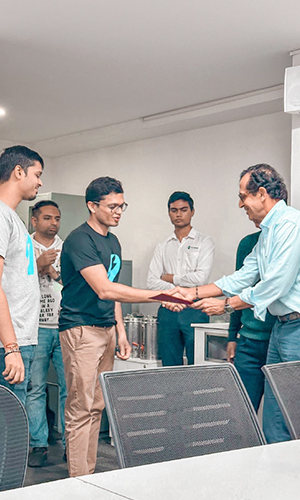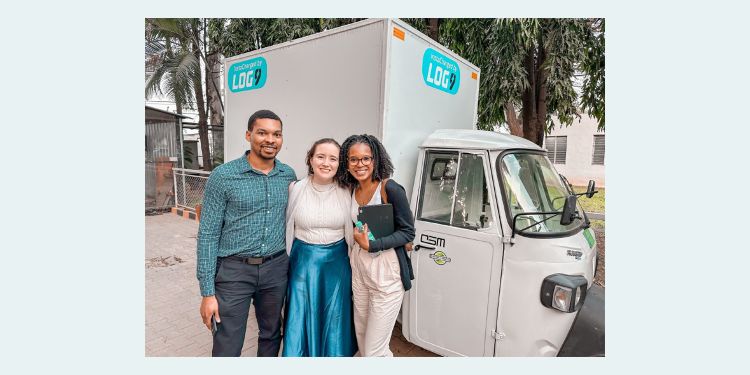Professor Vikram Gandhi’s Immersive Field Course (IFC) “Development while Decarbonizing: India’s Path to Net-Zero" delved into the critical aspect of decarbonization and sustainability goals amid India's rapid development. The course presented an opportunity for students to advance their knowledge of sustainability efforts, decarbonization, and net zero in the context of a broader development agenda. The class culminated in a series of site visits in January 2024 in Mumbai and Bangalore and this is one of 14 student essays that highlights their reflections on uncovering sustainable solutions across the country.
Introduction
As a cohort of HBS students on Professor Gandhi’s 'Development While Decarbonizing: India's Path to Net Zero' course, we found ourselves immersed in the epicenter of India's clean tech revolution. Our team, dedicated to clean-tech entrepreneurship, embarked on a journey to understand the intricate tapestry of India's burgeoning green tech landscape. A pivotal moment in our learning expedition was the site visit to Log 9 Materials, a company that epitomizes the fusion of innovation and environmental stewardship. Our visit coincided with a startup meetup hosted by Log 9, which created an unprecedented opportunity to engage with other green tech pioneers from India, fostering a collaborative climate-focused atmosphere that was at the center of the entrepreneurship, climate tech ecosystem in Bangalore.

Background of Log 9
In the heart of India's technological innovation wave stands Log 9 Materials, a beacon of nanotechnology and graphene innovation. Established in 2015 by Akshay Singhal and Kartik Hajela, (and later with Pankaj Sharma), two visionaries from IIT Roorkee, Log 9 stands out as a company not merely content with joining the clean energy race but determined to lead it, especially in tropical countries, by the dawn of 2030. From its nascent stages focusing on the multifaceted applications of graphene, Log 9's trajectory has been nothing short of meteoric. The company's foray into Aluminum-air fuel cells, oil spill containment, and the electrification of vehicles, including scooters and auto-rickshaws, has marked it as a trailblazer in clean energy alternatives.
With a successful Series A funding round that drew powerhouse investors like Sequoia Surge and Exfinity Venture, Log 9 has secured a formidable $31.7 million across multiple rounds of funding. This financial backing underscores the confidence and belief in Log 9's strategic vision, which is steadfastly aligned with creating a future where mobility and energy consumption are clean, efficient, and sustainable. From the team’s one day experience at the headquarters, we witnessed the company’s scrappy nature, commitment to innovation, and operational creativity.


Key Takeaways from the Log 9 Site Visit
The Entrepreneurial Manager (TEM) course at HBS introduced the Diamond-Square framework as a means to analyze an entrepreneurial venture. The framework helps highlight some areas of strength and key insights from our Log9 site visit. Overall, all ventures should use this framework to ensure that they have found “Product-Market-Fit”; this is even more critical in resource-constrained developing countries like India.
Context + Customer Value Proposition: The essence of entrepreneurship lies not just in creating solutions but in meticulously tailoring them to the needs of the market. Our visit to Log 9, was a deep dive into this philosophy. The company's founder highlighted the importance of Indian-specific focus, particularly in the EV sector, where international products often fail to accommodate the local nuances of climate, traffic, and regulatory dynamics. Log 9's commitment to customizing battery technology for the extreme heat and humid conditions common in India’s environment underscores the broader narrative of innovation that resonates with local contexts. This means that Log9 has a unique and well-differentiated CVP to offer OEMs as it seeks to gain new customers and grow.
Go-To-Market: One striking revelation was Log 9's strategy for targeting a commercial customer base. By focusing on commercial usage, Log 9 caters to clients who value functionality and cost over time over features and require robust solutions for extensive daily use. This approach is not only pragmatic but also resonates with the Indian market, where commercial vehicles are essential to the economy and the environment. With this GTM, Log9 is applying Judo strategy by building a strong & technically capable brand which is defensible vs. going to the larger retail side first.
Technology/Operations: Beyond the development of battery chemistries for the India context, Log 9's methodical use of data to enhance battery performance exemplifies how technology can lead to sustainable operational improvements. By analyzing fleet data, they've developed strategies to optimize battery usage, unlock sustainable fast charging, and prolong life. Thereby, encouraging drivers to adopt behaviors that contribute to the longevity and efficiency of their vehicles. This underscores their commitment to sustainability across the value chain while demonstrating their technical capabilities.

Team: Our visit also shed light on the company's ethos towards building technical talent. In a sector where specialized skills are scarce, Log 9 invests in its people, fostering a culture of learning and problem-solving. Log 9 Founder, Pankaj Sharma, stated, “Before you build the tech, you must build the people,” emphasizing Log9’s commitment to attracting and retaining the best talent.
Partners + Investors: The journey of Log 9 from its humble beginnings to a frontrunner in green technology is a testament to the power of nurturing a strong startup ecosystem. The company's close-knit relationships with suppliers and investors have cultivated a fertile ground for innovation, leading to significant achievements and a robust model for startup success. This collaborative approach has been crucial in Log 9's ability to adapt and thrive in a dynamic market.
Cash Flow Formula + Competition: Lastly, our discussions touched upon the ambition for international expansion and the prospect of an exit. Log 9 is eyeing markets beyond India as it offers a means to reach an appropriate TAM, leverage synergies, and hopefully increase likelihood of becoming profitable. It realizes that the technology it developed for India also has relevance in other markets that share India’s climatic conditions and large commercial two-, three-, and small four-wheeler fleets. Additionally, the competitive landscape means that international expansion invites foreign investment and the potential for strategic exit. This strategy is a reflection of the larger trend among Indian startups, like Pixxel, which, due to the relatively passive nature of Indian strategics in early-stage funding and acquisitions, often look outward for later-stage investments and exit opportunities.
Conclusion
Log 9’s dedication to aligning their products with the real-world demands of India's market, coupled with their commitment to empowering their workforce and strengthening startup ecosystems, sets a benchmark for aspiring green tech entrepreneurs globally.


